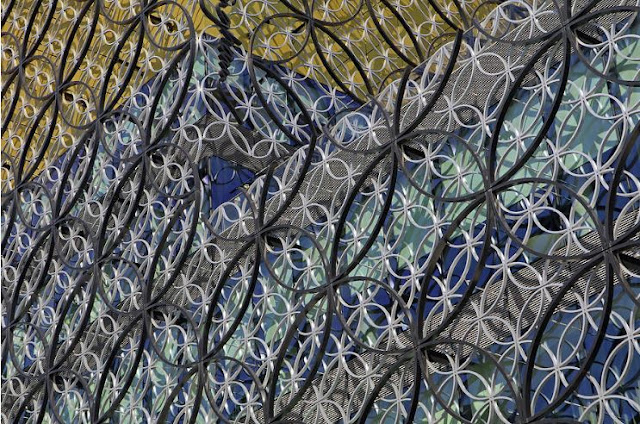 |
| Centenary Square |
Centenary Square is a public square on the north side of Broad Street in Birmingham, named in 1989 to commemorate the centenary of Birmingham achieving city status.
In 1991 the square was redesigned to complement the new International Convention Centre with new paving, railings and lamps designed by artist Tess Jaray, a fountain and several sculptures. During the construction and opening of the Library of Birmingham on the square in 2013 several of the elements of the 1991 design were removed and a library amphitheatre was built into the square.
The square is used as a staging area for many of the city’s main cultural events including the Frankfurt Christmas Market, Arts Festivals, Remembrance Day Services, New Year’s Celebrations and during Christmas hosts a temporary ice rink and the Birmingham Wheel. The buildings, from left to right, are the Birmingham Repertory Theatre, the Library of Birmingham and Baskerville House.
 |
| Library of Birmingham |
 |
| Library of Birmingham Facade |
The Library of Birmingham is situated on the west side of the city centre at Centenary Square, beside the Birmingham Rep (to which it connects, and with which it shares some facilities) and Baskerville House. Upon opening on 3 September 2013, it replaced Birmingham Central Library. The library, which is estimated to have cost £188.8 million, is viewed by the Birmingham City Council as a flagship project for the city's redevelopment. It has been described as the largest public library in the United Kingdom, the largest public cultural space in Europe, and the largest regional library in Europe. 2,414,860 million visitors came to the library in 2014 making it the 10th most popular visitor attraction in the UK.
The exterior of the building, from the first to the eighth floor is wrapped with an intricate metal façade, echoing the tunnels, canals and viaducts which fuelled Birmingham’s industrial growth.
 |
| Birmingham Symphony Hall |
The Birmingham Symphony Hall is a 2,262 seat concert venue in Birmingham, England which looks out onto Centenary Square, next to the Birmingham Rep. It was officially opened by the Queen in June 1991. It is home to the City of Birmingham Symphony Orchestra and hosts around 270 events a year. It was completed at a cost of £30 million. The hall's interior is modelled upon the Musikverein in Vienna and the Concertgebouw in Amsterdam. The venue, managed alongside Town Hall, presents a programme of jazz, world, folk, rock, pop and classical concerts, organ recitals, spoken word, dance, comedy, educational and community performances, and is also used for conferences and business events.
The Symphony Hall, widely considered one of the finest in the world, was designed by Percy Thomas Partnership and Renton Howard Wood Levin, with specialist help from Russell Johnson of Artec Consultants Inc..
 |
| Birmingham Symphony Hall Reflections |
Reflections from Birmingham Symphony Hall showing, from left to right, Baskerville House, the Library of Birmingham and, on the opposite side of the road, the Crowne Plaza Hotel.
 |
| Reflections from Birmingham Symphony Hall |
 |
| Boulton Watt And Murdoch |
Outside the House of Sport (formerly the Register Office) on Broad Street, opposite Centenary Square, stands the statue of Boulton, Watt and Murdoch, nicknamed 'The Golden Boys' or 'The Carpet Salesmen'. It is the work of William Bloye, formerly head of sculpture at Birmingham School of Art and was unveiled in 1956, although preliminary designs were drawn up in 1938.
The larger-than-life size figures are in bronze, with a gold finish, on a pedestal of Portland stone and are depicted discussing engine plans.
The three men pioneered the industrial revolution in late 18th century England. James Watt's improvements to the steam engine and William Murdoch's invention of gas lighting have made them famous throughout the world. Matthew Boulton, entrepreneur and industrialist, harnessed their talents in a company that made everything from tableware and copper coinage to steam engines. His home, Soho House, is now a museum. All three men are buried in St Mary's Church Handsworth, known as the 'Westminster Abbey of the Industrial Revolution'.
As usual, my work is available to purchase as original Wall Art in a variety of formats from stretched canvas or framed prints, metal or acrylic prints,or simply as standard prints for you to mount in your favourite picture frame. They are also available as greeting cards or printed onto iPhone or Galaxy phone cases, throw pillows or duvet covers or tote bags or shower curtains.
No comments:
Post a Comment